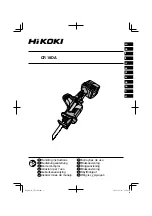
www.scheppach.com /
+(49)-08223-4002-99 /
+(49)-08223-4002-58
GB | 23
– Keep the handle dry, clean and free of oil and
grease.
15 Pull the plug out of the outlet
– Never remove loose splinters, chips or jammed
wood pieces from the running saw blade.
–
During non-use of the electric tool or prior to
maintenance and when replacing tools such as
saw blades, bits, milling heads.
16 Do not leave a tool key inserted
– Before switching on, make sure that keys and
adjusting tools are removed.
17 Avoid inadvertent starting
– Make sure that the switch is switched off when
plugging the plug into an outlet.
18 Use extension cables for outdoors
–
Only use approved and appropriately identified
extension cables for use outdoors.
– Only use cable reels in the unrolled state.
19 Remain attentive
– Pay attention to what you are doing. Remain
sensible when working. Do not use the electric
tool when you are distracted.
20 Check the electric tool for potential damage
– Protective devices and other parts must be care
-
fully inspected to ensure that they are fault-free
and function as intended prior to continued use
of the electric tool.
– Check whether the moving parts function fault
-
lessly and do not jam or whether parts are dam
-
aged. All parts must be correctly mounted and
all conditions must be fulfilled to ensure fault-
free operation of the electric tool.
–
The moving protective hood may not be fixed in
the open position.
– Damaged protective devices and parts must be
properly repaired or replaced by a recognised
workshop, insofar as nothing different is speci
-
fied in the operating manual.
– Damaged switches must be replaced at a cus
-
tomer service workshop.
– Do not use any faulty or damaged connection
cables.
– Do not use any electric tool on which the switch
cannot be switched on and off.
21 ATTENTION!
– Exercise elevated caution for double mitre cuts.
22 ATTENTION!
– The use of other insertion tools and other ac
-
cessories can entail a risk of injury.
23
Have your electric tool repaired by a qualified
electrician
– This electric tool conforms to the applicable
safety regulations. Repairs may only be per
-
formed by an electrician using original spare
parts. Otherwise accidents can occur.
6 Do not overload your electric tool
– They work better and more safely in the speci
-
fied output range.
7 Use the correct electric tool
–
Do not use low-output electric tools for heavy
work.
– Do not use the electric tool for purposes for
which it is not intended. For example, do not
use handheld circular saws for the cutting of
branches or logs.
–
Do not use the electric tool to cut firewood.
8 Wear suitable clothing
– Do not wear wide clothing or jewellery, which
can become entangled in moving parts.
–
When working outdoors, anti-slip footwear is
recommended.
– Tie long hair back in a hair net.
9 Use protective equipment
– Wear protective goggles.
–
Wear a mask when carrying out dust-creating
work.
10 Connect the dust extraction device
– If connections for dust extraction and a collect
-
ing device are present, make sure that they are
connected and used properly.
– Operation in enclosed areas is only permitted
with a suitable extraction system.
11 Do not use the cable for purposes for which it is
not intended
– Do not use the cable to pull the plug out of the
outlet. Protect the cable from heat, oil and sharp
edges.
12 Secure the workpiece
– Use the clamping devices or a vice to hold the
workpiece in place. In this manner, it is held
more securely than with your hand.
– An additional support is necessary for long
workpieces (table, trestle, etc.) in order to pre
-
vent the machine from tipping over.
–
Always press the workpiece firmly against
the working plate and stop in order to prevent
bouncing and twisting of the workpiece.
13 Avoid abnormal posture
– Make sure that you have secure footing and al
-
ways maintain your balance.
– Avoid awkward hand positions in which a sud
-
den slip could cause one or both hands to come
into contact with the saw blade.
14 Take care of your tools
– Keep cutting tools sharp and clean in order to
be able to work better and more safely.
– Follow the instructions for lubrication and for
tool replacement.
– Check the connection cable of the electric tool
regularly and have it replaced by a recognised
specialist when damaged.
– Check extension cables regularly and replace
them when damaged.
Summary of Contents for 3901105941
Page 18: ...www scheppach com service scheppach com 49 08223 4002 99 49 08223 4002 58 18 DE...
Page 222: ...www scheppach com service scheppach com 49 08223 4002 99 49 08223 4002 58 222 NL...
Page 223: ...www scheppach com service scheppach com 49 08223 4002 99 49 08223 4002 58 223...
Page 224: ...www scheppach com service scheppach com 49 08223 4002 99 49 08223 4002 58 224...
Page 226: ...www scheppach com service scheppach com 49 08223 4002 99 49 08223 4002 58...
















































